Global Tighter Recycled Fiber Market Forecast
- Global market for tighter recycled fiber worth US$0.6 Bn in 2022 likely to reach US$0.9 Bn in 2030
- Tighter recycled fiber market size poised to expand at a CAGR 5.5% between 2023 and 2030
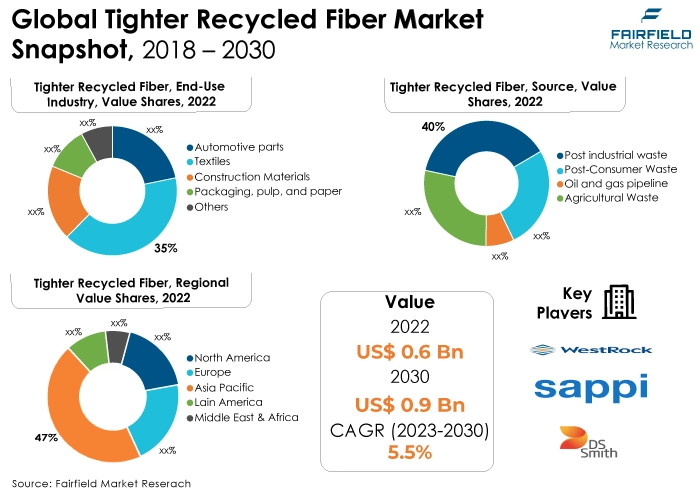
Quick Report Digest
- To meet the demands of various businesses, the more competitive recycled fiber market necessitates the collection, processing, and conversion of waste materials into usable fibers. Government laws favouring recycled materials and technological improvements in recycling processes have an impact on the industry's dynamic and environmentally sensitive nature.
- Increased investments in recycling infrastructure to enhance capacity, a rise in demand for tighter recycled fiber products, and cooperative efforts among stakeholders to promote a more resource-effective and sustainable circular economy are notable trends.
- The increased emphasis on environmental sustainability and eco-consciousness among consumers and businesses is a prominent trend in the market and a key factor in the more competitive recycled fiber market.
- The need for more tightly woven recycled fiber is driven by rising consumer awareness of eco-friendly and sustainable products across a range of industries. Customers today demand products with a smaller environmental footprint, which motivates businesses to use tighter recycled fiber to satisfy these demands.
- In 2022, the textile category controlled the market. Tighter recycled fiber is being used more and more in the textile sector, providing greener substitutes for traditional materials.
- The post-industrial waste category is highly prevalent in the market for tighter recycled fiber. Industries nowadays aim to reduce waste and utilise them most appropriately.
- The European region is expected to register the largest share of the global tighter recycled fiber market. Tighter recycled fiber adoption is being pushed by the region's tight environmental standards and circular economy focuses in several businesses.
- The market for tighter recycled fiber is expanding in Asia Pacific. Rapid urbanisation, industry, and an increasing emphasis on sustainability are the main factors fueling the region's progress.
A Look Back and a Look Forward - Comparative Analysis
The expansion of the market is being driven by social awareness of textile recycling and environmental concerns about the generation of textile waste. The Environmental Protection Agency (EPA) estimates that textile waste takes about 5% of landfill area. The average amount of textiles produced annually in the US is 25 billion pounds or 82 pounds per person. The market for textile recycled fiber is being driven by the aforementioned considerations.
The US has one of the greatest textile industries in the world, according to the National Council of Textile Organisation of the US Additionally, the US produces a significant amount of garbage from wasted textiles. The average American tosses away about 70 pounds of textiles every year, as per the Council for Textile Recycling. In addition, US Environmental Protection Agency Report 2022 states that 14.7% of all textiles in the nation were recycled in 2018. These elements have boosted the global demand for textile recycled fiber.
The average life of a garment is getting shorter, which contributes to an increase in the production of textile and clothing waste. Due to the landfill disposal and incineration process, forms greenhouse gas emissions, this has a prominent negative influence on the environment.
Additionally, it is projected that innovations in recycling practices and ground-breaking research in the area will support market expansion. For instance, LIST Technology AG showcased a lyocell T-shirt made completely of recycled material in February 2022 at the International Conference on Cellulose Fibres, announcing a breakthrough in the textile recycling business.
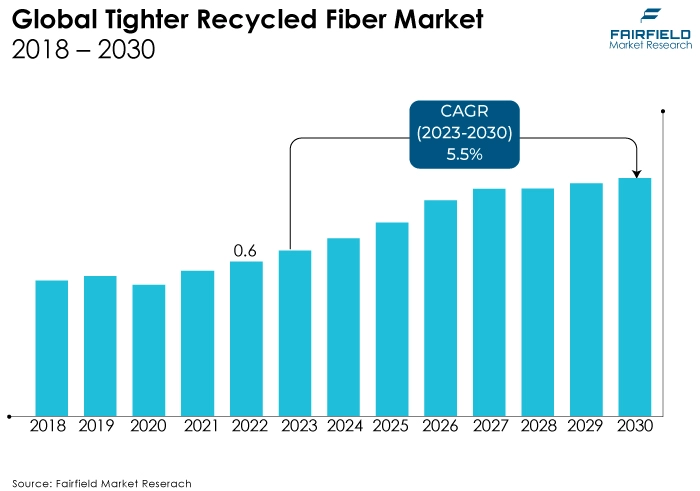
Key Growth Determinants
- Increased Demand for Light Vehicles
Recycled carbon fiber is used in the automotive, aerospace, and defence industries due to its better benefits, which include affordability, energy efficiency, lightweight design, and environmental sustainability. These fibers are used in many automotive applications, including lift gate systems, pressure containers, and battery boxes.
The demand for recycled carbon fibers is being driven by the increased environmental rules put in place by regulatory agencies like the European Union, and the US Environmental Protection Agency to limit carbon emissions.
A rise in pollution standards in China, and India has also raised the need for lightweight automobile components. Additionally, the aerospace and defence industries' growing need for lightweight materials would probably significantly fuel the market growth during the study period.
- Growing Environmental Concerns
Most of the raw materials needed to create goods based on carbon fiber are wasted, accounting for about 30% of the total. The requirement for recovering carbon fiber is driven by the stricter environmental regulations on waste landfills. Garbage that contains carbon can release greenhouse gases like CO2, and methane, which are hazardous to the ecosystem.
According to the European Union's Waste Framework Directive, landfilling is the least desired method of waste disposal. The need for carbon fiber recycling has increased as a result of the increased attention being paid to waste management and the dangers associated with rubbish that contains carbon, which is propelling the market growth.
- Rising Boom Around Eco-friendly Materials
Recycled carbon fiber can be used as a more economical and ecologically beneficial alternative to raw carbon fiber. The increasing demand for recyclable and environmentally friendly materials brought on by tighter regulations promotes the use of recyclable materials.
The End-of-Life Automobiles Directive, for instance, promotes recycling and provides financial incentives for environmentally friendly automobiles. In the European Community, eight to nine million tonnes of rubbish are produced each year as a result of outdated vehicles.
The Aircraft Fleet Recycling Association (AFRA) is supporting both the adoption of sustainable practices and aircraft recycling. The demand for recyclable materials has expanded globally due to a lack of landfill space for trash disposal.
Major Growth Barriers
- Quality Concerns
The contamination of recycled materials is one of the biggest risks to the market for tighter recycled fiber. The quality of the fiber can be diminished by impurities in the recycling stream, making it less suited for some applications and decreasing its overall market value.
- Availability of Cheaper Substitutes
The market for tighter recycled fiber may be threatened by the availability of less expensive virgin fibers. Due to financial constraints, businesses may occasionally choose virgin resources over tighter recycled fiber, which could affect the market's expansion.
Key Trends and Opportunities to Look at
- Technological Upgrades
The effectiveness and quality of manufacture of tighter recycled fiber have changed as a result of advancements in recycling technologies. Tighter recycled fiber is now more viable and appealing to producers looking for environmentally friendly alternatives thanks to advancements in sorting, cleaning, and processing techniques.
- Mounting Investments in Infrastructural Developments
As governments and the business sector engage in expanding and upgrading the recycling infrastructure, opportunities abound. These investments strengthen the recycling ecosystem, providing a consistent supply of tighter, higher-quality recovered fiber to satisfy the growing market demands. Additionally, enhanced waste management techniques allow for more effective recycling material collection and processing, which further supports market expansion.
- Shifting Consumer Demands
Tighter recycled fiber is more in demand across a range of industries because of rising customer awareness of and preferences for environmentally friendly and sustainable products. Customers today demand products with a smaller environmental footprint, which motivates businesses to use tighter recycled fiber to satisfy these demands.
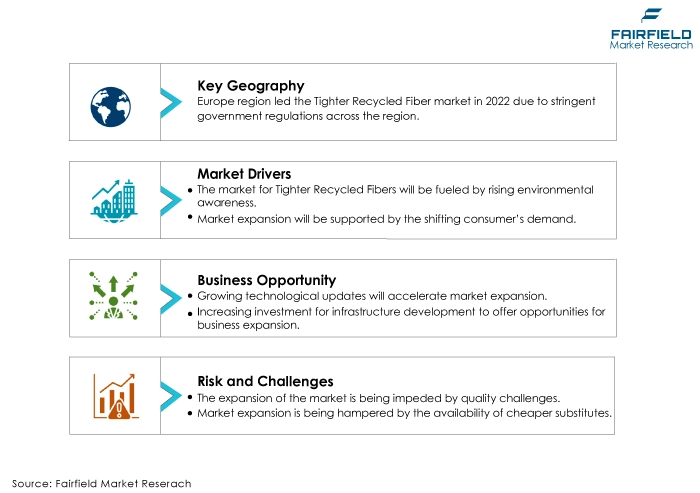
How Does the Regulatory Scenario Shape this Industry?
Governments around the world have enacted strict environmental laws and policies, which are essential in encouraging the use of more tightly woven recycled fiber. Industries are further encouraged to incorporate more recycled fiber into their products and processes through incentives, tax rebates, and regulations for employing recycled materials.
In addition, The American government has established objectives to raise consumer awareness of textile recycling. For instance, the Council of Textile Recycling (CTR) is guiding the government's initiative to attain zero waste by 2037. The Council of Textile Recycling (CTR) is focusing on post-consumer decision-making with this program and extending its outreach to manufacturers, brands, municipalities, retailers, and charities in addition to textile recyclers to raise recycling awareness.
Fairfield’s Ranking Board
Top Segments
- Textile Sector Continues to Dominate, Followed by Automotive Parts
Tighter recycled fiber is being used more and more in the textile sector, providing greener substitutes for traditional materials. Tighter recycled fiber adoption in textiles coincides with sustainable design and fabric choices, propelling the market towards more environmentally responsible practices as the fashion sector comes under increased scrutiny for its environmental footprint.
Furthermore, the automotive parts category is projected to experience the fastest market growth. The automobile industry has the chance to create lighter, more environmentally sensitive vehicles by using tighter recycled fiber in the production of automotive parts.
The usage of tighter recycled fiber in automotive components is becoming into a major market trend as there is a greater focus on cutting carbon emissions and implementing sustainable practices.
- Post-industrial Waste Remains the Most Preferred Source
Post-industrial waste as a source includes tighter recycled fiber made from manufacturing waste, such as extra paper or production process scraps. Post-industrial recycled fiber is becoming more popular as firms strive to cut waste and adopt circular economy principles.
The agricultural waste category is anticipated to grow substantially throughout the projected period. A recycled fiber made from plant and crop wastes, like as crop dregs. The use of agricultural waste for Tighter recycled fiber gives prospects to reduce environmental impact and improve resource efficiency as sustainable agriculture practices gain traction.
Regional Frontrunners
Europe Maintains Dominance, Expects Major Support from Governments
In terms of revenue share, the Europe region dominated the global market for textile recycled fiber in 2022. The market in the region is anticipated to grow significantly over the anticipated years as a result of rising government backing from various nations, and an increase in recycling-related programs.
The Trash and Resources Action Programme (WRAP), which was founded in the UK and is active throughout Europe with the assistance of regional administrations and private businesses, encourages the recycling of trash, including textile waste.
The capital of textile recycling and a well-known center for textile recycling is Italy. In Prato, Italy, where old rugs and clothes are customarily gathered from all over the world and turned into yarn, more than a hundred businesses have joined the Italian Textile and Recycling Association.
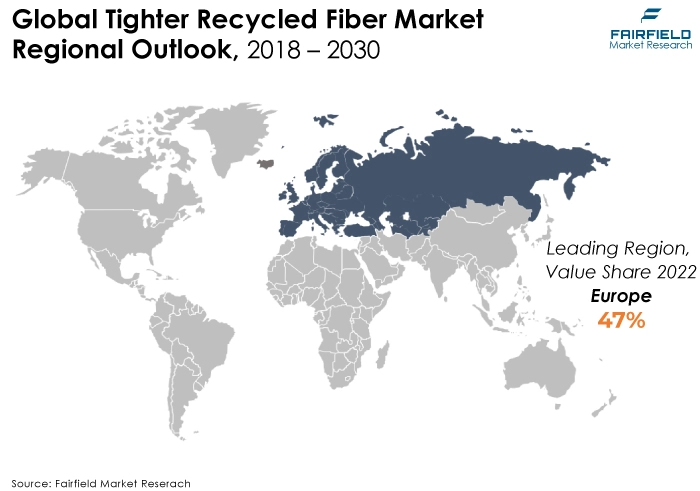
Asia Pacific
Asia Pacific is expected to exhibit the quickest CAGR. Owing to the growing worries about the environmental effects of textile waste, expanding government initiatives for managing textile waste, and ongoing development of cutting-edge technologies for textile recycling, it is anticipated that demand for textile recycling activities will rise in this region over the course of the forecast period.
Additionally, the expansion of e-commerce, and rising consumer demand for environmentally friendly packaging are significant factors behind the region's increased use of tighter recycled fiber in the packaging and paper industries.
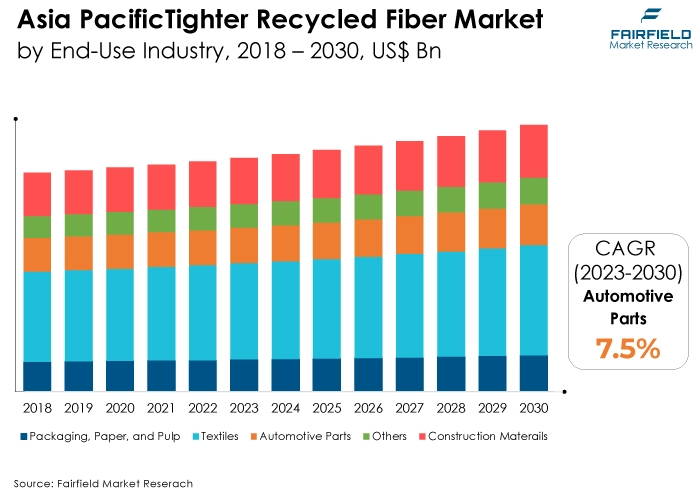
Fairfield’s Competitive Landscape Analysis
The global tighter recycled fiber market is a consolidated market with fewer major players present across the globe. The key players are introducing new products as well as working on the distribution channels to enhance their worldwide presence. Moreover, Fairfield Market Research is expecting the market to witness more consolidation over the coming years.
Who are the Leaders in the Global Tighter Recycled Fiber Space?
- Unifi Inc.
- Worn Again Technologies
- Birla Cellulose
- BLS Ecotech
- The Woolmark Company
- Ecotex Group
- DS Smith Plc
- International Paper Company
- WestRock Company
- Pratt Industries Inc.
- UPM-Kymmene Corporation
- Smurfit Kappa Group Plc
- Stora Enso Oyj
- Mondi Group
- Sappi Limited
Significant Company Developments
Partnerships and Collaborations
- August 2023: To comply with federal aviation laws and uphold its reputation as an environmentally friendly company, Joby Aviation, and Carbon Conversions have partnered to recycle the company's waste fiber.
- March 2022: Deakin University, and Gen 2 Carbon Limited have partnered to advance the growth of carbon fiber recycling in Australia.
- April 2023: In collaboration with Circ, Zara unveiled a line of women's clothing produced from recycled polyester and lyocell that was extracted from mixed textile waste. Additionally, Indorama Ventures Public Company Limited bought AG Resinas Ltda.'s PET recycling factory through one of its subsidiaries in June 2020. 100% of the company's equity was bought. In Juiz de Fora, Brazil, AG Resinas converts post-consumer PET into recycled PET flakes and pellets.
Product Launch
- April 2022: The creation of a brand-new item for the G-TEX product line was announced by Gen 2 Carbon Limited. Any resin system can be used to process G-TEX 60 gsm. The automobile and transportation, aerospace, and wind energy industries are anticipated to benefit from it.
Merger and Acquisition
- December 2021: Blackstone announced the acquisition of Sustana Group, a Wisconsin-based producer of environmentally friendly recycled fiber, paper, and packaging materials, via funds managed by its Blackstone Tactical Opportunities division, in New York.
An Expert’s Eye
Demand and Future Growth
Recycling textile waste promotes environmental sustainability. A prospective recycling strategy called upcycling maximises the use of energy, raw materials, and water while minimizing its negative effects on the environment. In addition, recycling textiles has a lower environmental impact than landfill disposal and textile incineration.
Resource recovery can produce significant environmental benefits by replacing goods derived from primary resources. Over the course of the projection period, all of the aforementioned variables are anticipated to stimulate market expansion.
Supply Side of the Market
Most of nations strive to increase their overall recycling of materials. Single-stream waste systems, which collect all types of recyclables in the same bin, are more common in the US than in European countries, where collection systems typically require businesses and consumers to separate their recyclable waste materials before collection.
In the US, single-stream systems currently account for about half of the separated recyclable materials collected from solid waste handled at municipal recycling facilities. Furthermore, China imports slightly more than 30 million tonnes of recycled fibers annually, which is roughly as much as the combined exports of the US, EU, and Japan. This is due to the fact that there isn't enough domestically produced virgin fiber and that too much packaging is exported for China to become entirely self-sufficient in recycled fiber.
Global Tighter Recycled Fiber Market is Segmented as Below:
By End-use Industry:
- Packaging, Paper, and Pulp
- Textiles
- Automotive Parts
- Construction Materials
- Others
By Source:
- Post-Consumer Waste
- Post-Industrial Waste
- Agricultural Waste
- Others
By Geographic Coverage:
- North America
- U.S.
- Canada
- Europe
- Germany
- U.K.
- France
- Italy
- Turkey
- Russia
- Rest of Europe
- Asia Pacific
- China
- Japan
- South Korea
- India
- Southeast Asia
- Rest of Asia Pacific
- Latin America
- Brazil
- Mexico
- Argentina
- Rest of Latin America
- Middle East & Africa
- GCC
- South Africa
- Egypt
- Nigeria
- Rest of the Middle East & and Africa
1. Executive Summary
1.1. Global Tighter Recycled Fiber Market Snapshot
1.2. Future Projections
1.3. Key Market Trends
1.4. Regional Snapshot, by Value, 2022
1.5. Analyst Recommendations
2. Market Overview
2.1. Market Definitions and Segmentations
2.2. Market Dynamics
2.2.1. Drivers
2.2.2. Restraints
2.2.3. Market Opportunities
2.3. Value Chain Analysis
2.4. Porter’s Five Forces Analysis
2.5. COVID-19 Impact Analysis
2.5.1. Supply
2.5.2. Demand
2.6. Impact of Ukraine-Russia Conflict
2.7. Economic Overview
2.7.1. World Economic Projections
2.8. PESTLE Analysis
3. Global Tighter Recycled Fiber Market Outlook, 2018 - 2030
3.1. Global Tighter Recycled Fiber Market Outlook, by End-use industry, Value (US$ Bn), 2018 - 2030
3.1.1. Key Highlights
3.1.1.1. Packaging, Paper and Pulp
3.1.1.2. Textiles
3.1.1.3. Automotive parts
3.1.1.4. Construction parts
3.1.1.5. Others
3.2. Global Tighter Recycled Fiber Market Outlook, by Source, Value (US$ Bn), 2018 - 2030
3.2.1. Key Highlights
3.2.1.1. Post-Consumer Waste
3.2.1.2. Post-Industrial Waste
3.2.1.3. Agricultural Waste
3.2.1.4. Others
3.3. Global Tighter Recycled Fiber Market Outlook, by Region, Value (US$ Bn), 2018 - 2030
3.3.1. Key Highlights
3.3.1.1. North America
3.3.1.2. Europe
3.3.1.3. Asia Pacific
3.3.1.4. Latin America
3.3.1.5. Middle East & Africa
4. North America Tighter Recycled Fiber Market Outlook, 2018 - 2030
4.1. North America Tighter Recycled Fiber Market Outlook, by End-use industry, Value (US$ Bn), 2018 - 2030
4.1.1. Key Highlights
4.1.1.1. Packaging, Paper and Pulp
4.1.1.2. Textiles
4.1.1.3. Automotive parts
4.1.1.4. Construction parts
4.1.1.5. Others
4.2. North America Tighter Recycled Fiber Market Outlook, by Source, Value (US$ Bn), 2018 - 2030
4.2.1. Key Highlights
4.2.1.1. Post-Consumer Waste
4.2.1.2. Post-Industrial Waste
4.2.1.3. Agricultural Waste
4.2.1.4. Others
4.2.2. BPS Analysis/Market Attractiveness Analysis
4.3. North America Tighter Recycled Fiber Market Outlook, by Country, Value (US$ Bn), 2018 - 2030
4.3.1. Key Highlights
4.3.1.1. U.S. Tighter Recycled Fiber Market by End-use industry, Value (US$ Bn), 2018 - 2030
4.3.1.2. U.S. Tighter Recycled Fiber Market Source, Value (US$ Bn), 2018 - 2030
4.3.1.3. Canada Tighter Recycled Fiber Market by End-use industry, Value (US$ Bn), 2018 - 2030
4.3.1.4. Canada Tighter Recycled Fiber Market Source, Value (US$ Bn), 2018 - 2030
4.3.2. BPS Analysis/Market Attractiveness Analysis
5. Europe Tighter Recycled Fiber Market Outlook, 2018 - 2030
5.1. Europe Tighter Recycled Fiber Market Outlook, by End-use industry, Value (US$ Bn), 2018 - 2030
5.1.1. Key Highlights
5.1.1.1. Packaging, Paper and Pulp
5.1.1.2. Textiles
5.1.1.3. Automotive parts
5.1.1.4. Construction parts
5.1.1.5. Others
5.2. Europe Tighter Recycled Fiber Market Outlook, by Source, Value (US$ Bn), 2018 - 2030
5.2.1. Key Highlights
5.2.1.1. Post-Consumer Waste
5.2.1.2. Post-Industrial Waste
5.2.1.3. Agricultural Waste
5.2.1.4. Others
5.2.2. BPS Analysis/Market Attractiveness Analysis
5.3. Europe Tighter Recycled Fiber Market Outlook, by Country, Value (US$ Bn), 2018 - 2030
5.3.1. Key Highlights
5.3.1.1. Germany Tighter Recycled Fiber Market by End-use industry, Value (US$ Bn), 2018 - 2030
5.3.1.2. Germany Tighter Recycled Fiber Market Source, Value (US$ Bn), 2018 - 2030
5.3.1.3. U.K. Tighter Recycled Fiber Market by End-use industry, Value (US$ Bn), 2018 - 2030
5.3.1.4. U.K. Tighter Recycled Fiber Market Source, Value (US$ Bn), 2018 - 2030
5.3.1.5. France Tighter Recycled Fiber Market by End-use industry, Value (US$ Bn), 2018 - 2030
5.3.1.6. France Tighter Recycled Fiber Market Source, Value (US$ Bn), 2018 - 2030
5.3.1.7. Italy Tighter Recycled Fiber Market by End-use industry, Value (US$ Bn), 2018 - 2030
5.3.1.8. Italy Tighter Recycled Fiber Market Source, Value (US$ Bn), 2018 - 2030
5.3.1.9. Turkey Tighter Recycled Fiber Market by End-use industry, Value (US$ Bn), 2018 - 2030
5.3.1.10. Turkey Tighter Recycled Fiber Market Source, Value (US$ Bn), 2018 - 2030
5.3.1.11. Russia Tighter Recycled Fiber Market by End-use industry, Value (US$ Bn), 2018 - 2030
5.3.1.12. Russia Tighter Recycled Fiber Market Source, Value (US$ Bn), 2018 - 2030
5.3.1.13. Rest of Europe Tighter Recycled Fiber Market by End-use industry, Value (US$ Bn), 2018 - 2030
5.3.1.14. Rest of Europe Tighter Recycled Fiber Market Source, Value (US$ Bn), 2018 - 2030
5.3.2. BPS Analysis/Market Attractiveness Analysis
6. Asia Pacific Tighter Recycled Fiber Market Outlook, 2018 - 2030
6.1. Asia Pacific Tighter Recycled Fiber Market Outlook, by End-use industry, Value (US$ Bn), 2018 - 2030
6.1.1. Key Highlights
6.1.1.1. Packaging, Paper and Pulp
6.1.1.2. Textiles
6.1.1.3. Automotive parts
6.1.1.4. Construction parts
6.1.1.5. Others
6.2. Asia Pacific Tighter Recycled Fiber Market Outlook, by Source, Value (US$ Bn), 2018 - 2030
6.2.1. Key Highlights
6.2.1.1. Post-Consumer Waste
6.2.1.2. Post-Industrial Waste
6.2.1.3. Agricultural Waste
6.2.1.4. Others
6.2.2. BPS Analysis/Market Attractiveness Analysis
6.3. Asia Pacific Tighter Recycled Fiber Market Outlook, by Country, Value (US$ Bn), 2018 - 2030
6.3.1. Key Highlights
6.3.1.1. China Tighter Recycled Fiber Market by End-use industry, Value (US$ Bn), 2018 - 2030
6.3.1.2. China Tighter Recycled Fiber Market Source, Value (US$ Bn), 2018 - 2030
6.3.1.3. Japan Tighter Recycled Fiber Market by End-use industry, Value (US$ Bn), 2018 - 2030
6.3.1.4. Japan Tighter Recycled Fiber Market Source, Value (US$ Bn), 2018 - 2030
6.3.1.5. South Korea Tighter Recycled Fiber Market by End-use industry, Value (US$ Bn), 2018 - 2030
6.3.1.6. South Korea Tighter Recycled Fiber Market Source, Value (US$ Bn), 2018 - 2030
6.3.1.7. India Tighter Recycled Fiber Market by End-use industry, Value (US$ Bn), 2018 - 2030
6.3.1.8. India Tighter Recycled Fiber Market Source, Value (US$ Bn), 2018 - 2030
6.3.1.9. Southeast Asia Tighter Recycled Fiber Market by End-use industry, Value (US$ Bn), 2018 - 2030
6.3.1.10. Southeast Asia Tighter Recycled Fiber Market Source, Value (US$ Bn), 2018 - 2030
6.3.1.11. Rest of Asia Pacific Tighter Recycled Fiber Market by End-use industry, Value (US$ Bn), 2018 - 2030
6.3.1.12. Rest of Asia Pacific Tighter Recycled Fiber Market Source, Value (US$ Bn), 2018 - 2030
6.3.2. BPS Analysis/Market Attractiveness Analysis
7. Latin America Tighter Recycled Fiber Market Outlook, 2018 - 2030
7.1. Latin America Tighter Recycled Fiber Market Outlook, by End-use industry, Value (US$ Bn), 2018 - 2030
7.1.1. Key Highlights
7.1.1.1. Packaging, Paper and Pulp
7.1.1.2. Textiles
7.1.1.3. Automotive parts
7.1.1.4. Construction parts
7.1.1.5. Others
7.2. Latin America Tighter Recycled Fiber Market Outlook, by Source, Value (US$ Bn), 2018 - 2030
7.2.1. Key Highlights
7.2.1.1. Post-Consumer Waste
7.2.1.2. Post-Industrial Waste
7.2.1.3. Agricultural Waste
7.2.1.4. Others
7.2.2. BPS Analysis/Market Attractiveness Analysis
7.3. Latin America Tighter Recycled Fiber Market Outlook, by Country, Value (US$ Bn), 2018 - 2030
7.3.1. Key Highlights
7.3.1.1. Brazil Tighter Recycled Fiber Market by End-use industry, Value (US$ Bn), 2018 - 2030
7.3.1.2. Brazil Tighter Recycled Fiber Market Source, Value (US$ Bn), 2018 - 2030
7.3.1.3. Mexico Tighter Recycled Fiber Market by End-use industry, Value (US$ Bn), 2018 - 2030
7.3.1.4. Mexico Tighter Recycled Fiber Market Source, Value (US$ Bn), 2018 - 2030
7.3.1.5. Argentina Tighter Recycled Fiber Market by End-use industry, Value (US$ Bn), 2018 - 2030
7.3.1.6. Argentina Tighter Recycled Fiber Market Source, Value (US$ Bn), 2018 - 2030
7.3.1.7. Rest of Latin America Tighter Recycled Fiber Market by End-use industry, Value (US$ Bn), 2018 - 2030
7.3.1.8. Rest of Latin America Tighter Recycled Fiber Market Source, Value (US$ Bn), 2018 - 2030
7.3.2. BPS Analysis/Market Attractiveness Analysis
8. Middle East & Africa Tighter Recycled Fiber Market Outlook, 2018 - 2030
8.1. Middle East & Africa Tighter Recycled Fiber Market Outlook, by End-use industry, Value (US$ Bn), 2018 - 2030
8.1.1. Key Highlights
8.1.1.1. Packaging, Paper and Pulp
8.1.1.2. Textiles
8.1.1.3. Automotive parts
8.1.1.4. Construction parts
8.1.1.5. Others
8.2. Middle East & Africa Tighter Recycled Fiber Market Outlook, by Source, Value (US$ Bn), 2018 - 2030
8.2.1. Key Highlights
8.2.1.1. Post-Consumer Waste
8.2.1.2. Post-Industrial Waste
8.2.1.3. Agricultural Waste
8.2.1.4. Others
8.2.2. BPS Analysis/Market Attractiveness Analysis
8.3. Middle East & Africa Tighter Recycled Fiber Market Outlook, by Country, Value (US$ Bn), 2018 - 2030
8.3.1. Key Highlights
8.3.1.1. GCC Tighter Recycled Fiber Market by End-use industry, Value (US$ Bn), 2018 - 2030
8.3.1.2. GCC Tighter Recycled Fiber Market Source, Value (US$ Bn), 2018 - 2030
8.3.1.3. South Africa Tighter Recycled Fiber Market by End-use industry, Value (US$ Bn), 2018 - 2030
8.3.1.4. South Africa Tighter Recycled Fiber Market Source, Value (US$ Bn), 2018 - 2030
8.3.1.5. Egypt Tighter Recycled Fiber Market by End-use industry, Value (US$ Bn), 2018 - 2030
8.3.1.6. Egypt Tighter Recycled Fiber Market Source, Value (US$ Bn), 2018 - 2030
8.3.1.7. Nigeria Tighter Recycled Fiber Market by End-use industry, Value (US$ Bn), 2018 - 2030
8.3.1.8. Nigeria Tighter Recycled Fiber Market Source, Value (US$ Bn), 2018 - 2030
8.3.1.9. Rest of Middle East & Africa Tighter Recycled Fiber Market by End-use industry, Value (US$ Bn), 2018 - 2030
8.3.1.10. Rest of Middle East & Africa Tighter Recycled Fiber Market Source, Value (US$ Bn), 2018 - 2030
8.3.2. BPS Analysis/Market Attractiveness Analysis
9. Competitive Landscape
9.1. Source vs. Source Heatmap
9.2. Manufacturer vs Source Heatmap
9.3. Company Market Share Analysis, 2022
9.4. Competitive Dashboard
9.5. Company Profiles
9.5.1. Unifi Inc.
9.5.1.1. Company Overview
9.5.1.2. Product Portfolio
9.5.1.3. Financial Overview
9.5.1.4. Business Strategies and Development
9.5.2. Worn Again Technologies
9.5.2.1. Company Overview
9.5.2.2. Product Portfolio
9.5.2.3. Financial Overview
9.5.2.4. Business Strategies and Development
9.5.3. Birla Cellulose
9.5.3.1. Company Overview
9.5.3.2. Product Portfolio
9.5.3.3. Financial Overview
9.5.3.4. Business Strategies and Development
9.5.4. BLS Ecotech.
9.5.4.1. Company Overview
9.5.4.2. Product Portfolio
9.5.4.3. Financial Overview
9.5.4.4. Business Strategies and Development
9.5.5. The Woolmark Company.
9.5.5.1. Company Overview
9.5.5.2. Product Portfolio
9.5.5.3. Financial Overview
9.5.5.4. Business Strategies and Development
9.5.6. Ecotex Group
9.5.6.1. Company Overview
9.5.6.2. Product Portfolio
9.5.6.3. Financial Overview
9.5.6.4. Business Strategies and Development
9.5.7. DS Smith Plc.
9.5.7.1. Company Overview
9.5.7.2. Product Portfolio
9.5.7.3. Financial Overview
9.5.7.4. Business Strategies and Development
9.5.8. International Paper Company
9.5.8.1. Company Overview
9.5.8.2. Product Portfolio
9.5.8.3. Financial Overview
9.5.8.4. Business Strategies and Development
9.5.9. WestRock Comapny
9.5.9.1. Company Overview
9.5.9.2. Product Portfolio
9.5.9.3. Business Strategies and Development
9.5.10. Pratt Industries Inc.
9.5.10.1. Company Overview
9.5.10.2. Product Portfolio
9.5.10.3. Financial Overview
9.5.10.4. Business Strategies and Development
9.5.11. UPM-Kymmene Corporation
9.5.11.1. Company Overview
9.5.11.2. Product Portfolio
9.5.11.3. Financial Overview
9.5.11.4. Business Strategies and Development
9.5.12. Smurfit Kappa Group Plc.
9.5.12.1. Company Overview
9.5.12.2. Product Portfolio
9.5.12.3. Financial Overview
9.5.12.4. Business Strategies and Development
9.5.13. Stora Enso Oyj
9.5.13.1. Company Overview
9.5.13.2. Product Portfolio
9.5.13.3. Financial Overview
9.5.13.4. Business Strategies and Development
9.5.14. Mondi Group
9.5.14.1. Company Overview
9.5.14.2. Product Portfolio
9.5.14.3. Financial Overview
9.5.14.4. Business Strategies and Development
9.5.15. Sappi Litd.
9.5.15.1. Company Overview
9.5.15.2. Product Portfolio
9.5.15.3. Financial Overview
9.5.15.4. Business Strategies and Development
10. Appendix
10.1. Research Methodology
10.2. Report Assumptions
10.3. Acronyms and Abbreviations
|
BASE YEAR |
HISTORICAL DATA |
FORECAST PERIOD |
UNITS |
|||
|
2022 |
|
2018 - 2022 |
2023 - 2030 |
Value: US$ Million |
||
|
REPORT FEATURES |
DETAILS |
|
End-use Industry Coverage |
|
|
Source Coverage |
|
|
Geographical Coverage |
|
|
Leading Companies |
|
|
Report Highlights |
Key Market Indicators, Macro-micro economic impact analysis, Technological Roadmap, Key Trends, Driver, Restraints, and Future Opportunities & Revenue Pockets, Porter’s 5 Forces Analysis, Historical Trend (2019-2021), Market Estimates and Forecast, Market Dynamics, Industry Trends, Competition Landscape, Category, Region, Country-wise Trends & Analysis, COVID-19 Impact Analysis (Demand and Supply Chain) |
